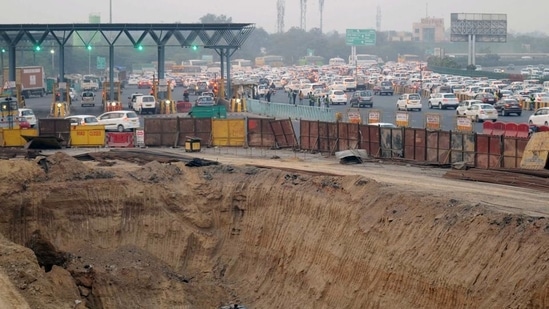Building ban in Delhi lifted, calls grow to reopen schools
The move was questioned by experts who pointed out that construction is a major contributor to pollution, while keeping students out of schools after in-person classes barely resumed following a near 20-month shutdown will further the significant losses in learning for children.
The Delhi government on Monday said the ban on construction and demolition (C&D) activities had been lifted across the capital, citing an improvement in air quality; however, no decision was taken to resume physical classes at schools, colleges and technical institutions, with a meeting now scheduled on November 24.

The move was questioned by experts who pointed out that construction is a major contributor to pollution, while keeping students out of schools after in-person classes barely resumed following a near 20-month shutdown will further the significant losses in learning for children.

“In view of the improvement in the air quality and inconvenience caused to workers, we have decided to lift the ban on construction and demolition activities... the government will continue to monitor dust control measures,” state environment minister Gopal Rai said. The ban on trucks carrying goods not considered essential supply will continue.
Shutting schools is listed under the “severe plus” or “emergency” category of the Graded Response Action Plan (Grap) -- air quality in Delhi was in the lower end of “very poor” category on Monday.
Santosh Harish, fellow at the Centre for Policy Research (CPR), said the notion that keeping children at home will reduce exposure was not rooted in science. “If the idea is to reduce exposure, you could say the exposure is similar, or perhaps even higher, at homes. If one has to spend public money, then instead of using it on large smog towers, air purifiers can be installed at schools by the government. Physical classes are important for the learning process,” he said, stating if construction activities were being allowed, there was a clear argument to resume classes too.
Experts also called for more proactive decisions that are based on real-time air quality and forecasting mechanisms.
Delhi’s air remained between the higher end of the “very poor” category and the “severe” category beginning November 2, with the air quality index touching a season’s high of 471 (severe) on November 12.
The next day, directions were issued by the Supreme Court, asking the Centre to hold an emergency meeting by November 16 and for states to look at extreme measures such as a two-day lockdown to bring down pollution.
When directions to shut schools and stop construction activities across NCR were finally issued on November 16 by the Centre-led Commission for Air Quality Management (CAQM), the AQI began dropping. Delhi’s average AQI has since remained below the 400 mark, dropping down to 311 (very poor) at 4pm on Monday – the lowest recorded since the 4pm bulletin on November 2, when the AQI was 303. By 10pm, the 24-hour average AQI slipped further to 288 (poor).
Conditions are forecast to improve further on Tuesday as strong surface winds continue to blow across the region, agencies said.
Meenakshi Kuhar, president of Naya Samaj parents association, said that while parents were concerned about the impact of pollution on children’s health, they were also concerned about the loss of studies due to frequent closure of schools.
“Whenever schools are closed on account of some reason or the other, there is loss of studies. Parents are definitely concerned about studies since online classes are not as good as regular in-person classes. Health of children is also an important factor due to which parents are compelled to wait till the situation improves. Pollution needs to be controlled so that children can safely resume school,” said Kuhar.
A second expert said authorities must be think ahead when it comes to tackling pollution, and that shutting schools cannot be among the first responses.
Anumita Roychowdhury, executive director, research and advocacy at the Centre for Science and Environment (CSE), said closure of schools is listed in the highest category of Grap in order to reduce exposure to “severe plus” or “emergency” air levels, but with air quality fluctuating based on meteorological conditions, it is more important to rely on forecasting mechanisms.
“We need to rely on a system that can forecast possible severe or severe plus air days ahead and then there can be a one or a two day break from physical classes, but it does not make sense to stop classes when air quality is improving. There is a need to rely on forecasting more for future decision making,” she said.
Roychowdhury’s comments tie in with the problem in the pollution response plan that has persisted for years: the core of the efforts is largely reactive, instead of being proactive. Every year, predictable meteorological conditions and the practice of burning farm residue by farmers in neighbouring states makes the air in the National Capital Region hazardously polluted.
Experts said, in such situations, the indoor air quality could at times be even worse than outdoor conditions, and holding online classes was not a guarantee of reduced exposure.
“In winters, the practice to shut down doors and windows to prevent polluted air from coming inside can over time trap pollutants inside. There are different sources of pollution indoors too and so the argument that the exposure is being reduced is not always valid,” said Priyanka Kulshreshtha from the Society from Indoor Environment (SIE).
The government on Monday said while the ban on construction activities had been lifted, sites violating dust suppression norms will be shut down immediately with a penalty imposed on the spot.
“We will not even wait to issue a notice, but issue a penalty and shut down the site first. A decision on other measures such as resumption of classes, government offices and on possibly allowing CNG trucks into Delhi, will be taken in a meeting on November 24, which will involve different stakeholders and government departments,” Rai said on Monday.






